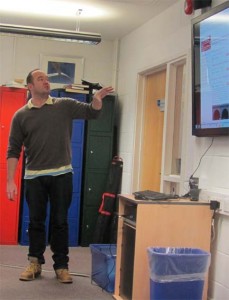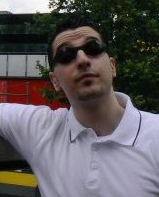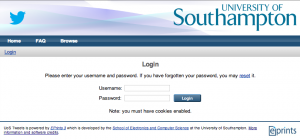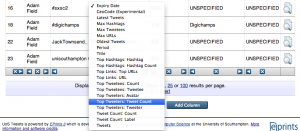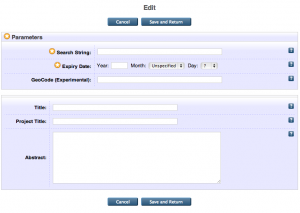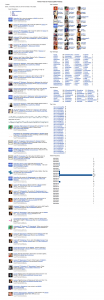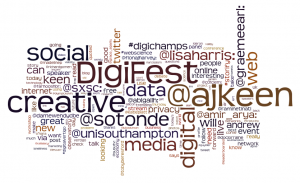
The 2013 Digital Literacies Conference #sotonMOOC
![]() April 25, 2013
April 25, 2013
by Lisa Harris
Written by @garethpbeeston and first published on the #digichamps blog:
The #SotonMOOC conference held today was host to a number of prestigious people from UK businesses and Universities, hoping to debate the challenges involved with building, moderating and launching a MOOC.
The event was kicked off by our very own @HughDavis who spoke about the projects in which @CITESoton is involved with across the University and how we can develop online education to cater to the digital arena. Following this, presentations from @CMSinclair, from Edinburgh University, and @Sheilmcn, from CETIS, gave their thoughts on how MOOCs should be developed and to what extent these challenges play a part in the MOOCs that they each have been involved with.
Many famous faces of the MOOC world enjoyed their well-earned coffee break as they recessed for pastries and hot drinks, provided by the University of Southampton catering department. Lovely grub!
To recommence the event, the #Digichamps, @GarethPBeeston and @RenaldoBLive, took to the floor providing a #DrawMyLife video on how the Digichamps came to be and how they can help staff around the University to become more digitally literate. Following on from this were two amazing sessions which focused on various projects around the University that are involved with digital literacies and the use of Web tools for an engaging and enthralling experience online.
A session on “Cool Social Media Tools” was conducted after the presentations that showed us how plugins on @Wordpress can provide an increase in functionality and interactivity on various sites involved with research, education and business. @katieonthetweet, another #Digichamp, also presented an inspiring presentation on an app that allows for the coordination of class recordings, richer media, timetables, notes and support for students at University.
The mixture of cool social tools carefully led onto a session conducted by Prof. @mweller from the Open University. This presentation was streamed online via a Google Hangout, showing practically the extent of the use of Web tools within education. This fantastic presentation inspired many around the room giving a great insight into the running of #H8170Open and Open Educational Resources through MOOCs.
After the lunch break, many delegates took part in a break-out session where various people would debate on the certain challenges, strengths and affordances involved with the creation, development, maintenance and distribution of content and MOOCs themselves. These included using video for further engaging tools, staying safe online and awesome apps in the classroom.
A final presentation to close the event was performed by Mark Lester, who is currently the Head of Strategy & Development at the Open University and a member of the Executive Team @FutureLearn (an initiative to drive open learning on the Web).
Many of the delegates were engaged, inspired and satisfied with an all-round successful event organised by our very own @LisaHarris and @FionaJHarvey. Many thanks to the digichamps, video teams and all delegates were announced to close the event. We wish everybody every success in creating their online learning tools and courses in the future.
Digital Economy Success Stories
![]() April 22, 2013
April 22, 2013
by Lorraine Warren
Readers of this blog might be interested in some of the activities going on at the Centre for Strategic Innovation which has really bedded in since our launch in November 2011. I wanted the CSI, in the spirit of innovation, to be a bit disruptive – my vision was, recognition for top-quality research, externally and internally, but also, to be experimental, to reach out and be interdisciplinary, and to connect with industry on leading edge knowledge exchange. I also wanted the ethos to be open to new suggestions, accessible, bottom-up and fun.
Anyway we’ve had a good start, particularly gaining new research recognition internally and externally in the EPRSC/Digital Economy/New Economic models strand. For example, I just obtained a 3K literature review grant, “Digital Disruption of the Value Creation Ecosystem– How new business models emerge”. This extends my earlier work as part of Creator which was again funded by the EPSRC and addressed business models in the digital domain.
But more importantly, there’s news of a significant £780,000 EPSRC research grant award to Prof. mc Schraefel of ECS and our own Dr. Stephen Rhys Thomas, leading a multidisciplinary team from Southampton drawn from ECS, Management and Economics. The successful bid was in response to an EPSRC Digital Economy call for New Economic Models. Congratulations to all concerned!
This EPSRC/DE/NEMODE research strand (value creation, lean/agile business models, underlying processes) has been complemented with a seminar series, Temporality and value at the intersection of arts and technology: advancing theoretical and methodological development and two collaborative events with ECS and the Digital Economy USRG (thanks to Lisa and Graeme), SXSC1and 2 that have brought in 00s of people from across the university, region, and industry, exciting interest as a rapid-platform for knowledge exchange, future research collaborations, especially in ECS, and also, check out the link to see the fun part, some great vids here.
As well as that strand, there are many, many other areas of interest, publications, grants, developments and initiatives I could have included here – this is just to give a flavour. Again with ECS we’re hosting an IET-sponsored Raspberry Pi event on April 25 (sold out), and a lunch meeting with Qinetiq in May. I’ll be organising a lunch meeting down the line to discuss these developments and future collaborations, so watch out for the date. So please do get in touch if there’s anything we can usefully collaborate on.
#WebSci13 is just 3 weeks away…
![]() April 10, 2013
April 10, 2013
by Lisa Harris
It is not too late to book your place in Paris :-)
The Web demands new ways of working across traditional academic disciplines. Web Science builds skills and expertise in the technical underpinnings of the Web, the social processes that have shaped its evolution, and the impact of the Web on society. The presentations at #WebSci13 will address these contemporary issues across a wide range of applications from healthcare to cybersecurity.
While the deadlines for presenting have now passed, registrations from businesses, academics, policy makers and students who would like to attend the event are most welcome.
Some of the highlights you can expect at the Conference are:
Day 1 – Thursday 2nd May
Keynotes from Vint Cerf, co-inventor of TCP/IP and “Father of the Internet”, and Cory Doctorow, novelist, technology activist and co-editor of the popular weblog Boing Boing. There will also be paper presentations on a wide range of cutting edge Web Science projects, a lively Pecha Kucha session of short sharp talks and an evening Reception.
Day 2 – Friday 3rd May
A full day of poster sessions, papers and panels – followed by an evening banquet on the Seine.
Day 3 – Saturday 4th May
Debate how the web is revolutionising society, and the event concludes with a final selection of papers.
A draft programme is now available
Digital Literacies Conference 2013: Online Learning and MOOCs
![]() March 22, 2013
March 22, 2013
by Lisa Harris

The second Digital Literacies Conference will take place in Garden Court, Highfield Campus on 24th April. This year’s theme is “Online Learning and Massive Open Online Courses” (MOOCs)
There will be contributions from people involved in the development of MOOCs from Edinburgh and the Open University (including Futurelearn) as well as the student perspective of what it is like to participate in a MOOC.
On the theme of online learning, we have contributions from students on the Curriculum Innovation Module ‘Living and Working on the Web’ about their experience as “blended learning” students.
We will be demonstrating educational uses of some new social tools such as Google Hangout, with the help of the Student Digital Champions
For more details of the timetable and speakers, and to reserve your place, see Fiona Harvey’s CITE post.
Digital Literacy Workshops
![]() February 27, 2013
February 27, 2013
by Lisa Harris
Fiona Harvey and myself have a number of workshops coming up over the next few weeks that may be of interest to staff and students – more information and booking links are here
These are informal sessions with coffee and cake and all are welcome
Thanks
Lisa
Blogging Workshop
![]() January 11, 2013
January 11, 2013
by Lisa Harris
Graeme Earl, Alison Simmance, Fiona Harvey, Peter Wheeler and myself went down to Avenue Campus the other day to run the first in a series of interactive blogging workshops. We were demonstrating the new University blogging system and we included a number of examples of how and why academics and students should be blogging effectively.
Thanks to Karen Woods for the photography!
The full pack of slides is here:
We trialled the Panopto lecture capture system to record our efforts, and if you are really keen you can watch the whole session…including the infamous lollipop scene at 1 hour 17 mins :-)
Meet the Student Digital Champions
December 19, 2012
by Farahnoosh Berahman
Digital Champions are a group of enthusiastic students who are supporting staff and fellow students with new digital products and services.
Get more information about the Digital Champions’ activities by liking the Facebook page
If you are interested in becoming a Digital Champion please feel free to get in touch and join our Facebook group
And check out our video!
Meet the Digital Champions:
George ‘Gigi’ Georgiev
George has studied MSc Digital Marketing, BSc Management, and went to a Spanish high school.
He is interested in advertising, art, video games, politics, martial arts, media, history, scuba diving, Football (fanatic fan of Barcelona), Italian cuisine lover (but a terrible chef!)
Twitter: @Good_boy113
LinkedIn: uk.linkedin.com/in/georgigeorgievmarketing
Ivan Melendez
Ivan is a Japanese speaking Mexican who recently graduated from the MSc in Knowledge and Information Systems Management at the University of Southampton. He has been involved in different projects regarding the use of social media in live events and his passions are reading, music and photography
Twitter: @IvanMelendezCh
LinkedIn: http://www.linkedin.com/in/martinivanmelendez/en
Amir Arya Arjmand
Amir is a graduate in MSc Web Technology from the University of Southampton. He has done his BSc in Information Technology Engineering. His general research interest is on Web Sciences especially Semantic Web and Social Networks. He loves finding new friends, taking photos in nature, and as a technology geek, he enjoys trying out new Web services.
Amir, among other things, refers to himself as a strategic manager precisely, an e-business planner. He has over nine years of work experience and enjoys being Digital Champion.
Twitter: @amir_arya
LinkedIn: http://www.linkedin.com/in/amiraria
Personal Website: http://www.amirarya.com/
Katie Spires
Katie is a Web Science PhD student, looking into the use of mobile technology to help students with dyslexia access higher education. She has a master’s degree in Web Science and a degree in Education.
Katie is currently helping a University in London with their deployment of iPads. She is particularly interested in teaching and helping both students and academics with digital literacy skills and the use of technology in the Classroom specifically higher education.
Twitter: @katieonthetweet
LinkedIn: uk.linkedin.com/pub/katie-spires/5b/75b/391/
Personal Website: katieontheweb.com
Nader Tibi
Nader is currently doing an MSc in Digital Marketing. He has a BSc in Marketing with six years of work experience in Healthcare Marketing. Nader likes to keep up with the latest in marketing, technology, and electronic entertainment industries. He is also a fan and a practitioner of sports, music, and photography.
Twitter: @ntibi04
LinkedIn: uk.linkedin.com/pub/nader-tibi/11/910/597
Evi Sopasi
Evi studies MSc Digital Marketing, and is interested in marketing and social media. For Evi joining the Digital Champions is an opportunity to broaden her horizons, gain new experience, and therefore gain more self-confidence concerning the field of her studies and the digital world in general.
Twitter: @ESopasi
LinkedIn: gr.linkedin.com/pub/evi-sopasi/52/682/231
Nikoletta Toumazatou
Nikoletta studied BSc in Marketing and Advertising. She is currently studying MSc in Digital Marketing at the University of Southampton. Nikoletta is passionate about new technologies, social media and their potentials.
She is interested in sharing data by using interactive forms of communication, and fascinated by online marketing and this ‘brand new’ approach of businesses to interact and communicate with their customers.
Nikoletta is very excited about travelling around the world and to broaden her horizons by getting along with people, understanding their cultures, attitudes, and habits.
Twitter: @speckidea
LinkedIn: uk.linkedin.com/pub/nikoletta-toumazatou/51/b71/398
Florence Broderick
Florence studies French, Spanish and European Studies. The European Studies part has allowed her to take modules in a wide range of disciplines including management and politics. During her year abroad period in Madrid, she was fortunate enough to work with two different start-ups (Ditit and Timpik) in an accelerator programme called Start-up Boot camp. In this time she became particularly interested in social media and email marketing. She is a keen cricketer and an absolute foodie.
Twitter: @FloBroderick
LinkedIn: uk.linkedin.com/in/flobroderic
Nipawan Charoensuksai
Nipawan is currently studying MSc Digital Marketing with the background in Marketing and interest in social media. She is fascinated by how peoples’ behaviour changes over time and the impact that it poses to business sector. Nipawan believes that the future of marketing is digital marketing and there will be no boundaries between online and offline aspects, and everything is blending together more and more.
Twitter: @NipawanCh
LinkedIn: uk.linkedin.com/pub/nipawan-charoensuksai/34/1bb/b1b
Farahnoosh Berahman
MSc in Human Resource Management, and the dissertation was about the ways in which the popularity of social networking websites has influenced the recruitment strategy of employers.
She is interested in how technology has improved the ways in which people communicate with each other. She believes that Social Media can enable companies build a two-way relationship with their stakeholders and therefore gain a competitive advantage.
Twitter: @farnooshbr
LinkedIn: http://www.linkedin.com/in/farahnooshberahman
Maraim Elbadri
Maraim is a fourth year MEng computer Science student. Her major interests are social media, specially its impact on people’s behaviour, open education and politics. She has been involved in many societies and projects in web and social developments. Her passions are reading, learning languages, photography, sustainability and exploring other cultures.
Twitter: @maraimmasoud
LinkedIn: http://www.linkedin.com/pub/maraim-masoud/16/384/580
Making the Digital Physical
December 14, 2012
by Javier Pereda
On the 10th of December, I was invited to attend to an event in Manchester organised by Lancaster CX Lab called ‘Making the Digital Physical’. CX short for Creative Exchange is a research group focused on the transformation of digital to physical and how is it presented in the public space.
The purpose of this event was to collaborate in a workshop trying to come up with new ways of making the digital into physical. The workshop involved several academics from universities such as Newcastle University, Dundee University, Anglia Ruskin and University of Southampton. It also included industry members such as BBC R&D, Madlab, Makie Lab and Matmi among others. Many members from the CX Lab were also involved.
During the workshop, we were given a presentation introducing some Tangible User Interfaces (TUI), to evidence previous work and produce some ideas. Some of the previous projects included: Virtual Gravity, Siftables, Necomimi, Immaterials, Information Shadows, 3D Photo Booth and the Skylanders video game. There are many research and commercial project where physicality plays a big role. As a Web Scientist, my research interest is directly related on the transition from Web to physical and the different factors that influence this transition.
We brought several objects that intended to represent this connection in between digital and physical. For example, I brought some silly putty. By changing the properties of silly putty, we can change its conductivity and therefore use it as a electronic device. It’s affordance then becomes directly related to the software. There were many objects and visions of how these object could be used or researched. Here is a list of some of them:
| An onion | Used to present layers of information |
| Blood test kit | Transfer of bio-data to digital |
| The Rape of Proserpina | Digital and physical representation of emotions |
| Cookie | Representation of digital cookies |
| Feather | Transfer of feeling. What feels good? |
After presenting some of the objects and the several research areas that this could rise, we proceeded to analyse in how many ways that area could be researched. The group I was working with chosen representing emotion. This idea was risen from the Rape of Proserpina.
After debating several ideas, we came up with two ‘prototypes’ that could open some research paths:
The Self Shelf
When we connect to technology, it does not reflect how we really feel. Moreover, we present different identities when we are connected. Different personalities are developed depending on the social group that we engage with. The idea behind was to build a shelf that contained self-adaptive objects that re-shaped themselves according to our mood. On the other hand, the objects could also re-shape according to the social group member that was visiting on that day, presenting the correct or desired personality on the shelf.
Physical Playlists
The second prototype was a object printer that embedded music into the objects. This allowed creating physical playlists. It was mentioned that when people used to make mix-tapes, they embedded their feelings on the creation of it. This idea aims to emulate that feeling that gets printed. This way the set of objects can be given away as a gift that contains emotions.
There were many other ideas where different members proposed how to engage with physical data. For example visualising human energy or scanning memories. All these projects aimed to engage with understanding markets, enabling technology and developing user profiles. Ideally, these projects could be inserted within a business model.
This was a very interesting experience where people from different backgrounds proposed various outputs and research opportunities.
We used the exercise to develop a creative proposal where different research and industry challenges were raised. In this case I put myself as head of one of the projects and proposed some areas and specific team members from different universities including University of Southampton and Lancaster University and commercial companies that can be able to collaborate. CX Lab then analyses the different proposals provided by the different teams and individuals and selects three or four projects. Once the projects have been selected, CX Lab funds those projects for the determined time and the selected team members to be able to fulfil that proposal. These type of workshops provide a good environment for collaboration and exchange of ideas, especially ideas that can be put forward for research and industry projects.
Twitter harvesting
December 14, 2012
by Amir AryaArjmand
By Amir Aryaarjmand.
At the Creative DigiFest #SxSC2, Adam Field talked about a ‘Lightweight Twitter Harvester’, featuring his service. I arranged an interview with him to know more about this service and here is the summary of my interview, a tutorial on how to use the service and comments from colleagues working on related initiatives.
Regarding the motivation of building the Twitter harvester, Adam Field said “[twitter] data is ephemeral unless you actively harvest it, it disappears after of couple of weeks; so, what I want to provide is a service, here at the University, for non-technical people who want to harvest small streams of tweets”.
Introducing the harvester
Adam’s Twitter harvest service is an extension that runs on top of ePrints. Prior to Adam’s job with iSolutions, as part of his work for ePrints services he was involved with a number of projects. This Twitter harvest service is one of the capabilities for ePrints that they explored. The current pilot service is for lightweight Twitter harvesting and archiving. As the service is a pilot the use of it is limited for the small events or projects that are no more than 1000 tweets per day. The service has three sides to it: (1) It harvests tweets, (2) It preserves the harvested tweets and, (3) It allows users to download the stored tweets.
A. Create an account
The service is available for all academic staff and graduate students of the University of Southampton. To create an account you need to send an email to Adam Field af05v@soton.ac.uk requesting an account.
B. Login to the service
Once your request has been approved by Adam Field, you can access the service at http://tweets.soton.ac.uk. Click on login and enter the service using your university ID and password.
C. Manage Twitter Feed
Logging in will automatically take you to the ‘Manage Twitter Feeds’ page, which lists all feeds currently being harvested by all users of the system. On this page you can:
- Access to the list of items that are already harvesting:
- Filter the items that are already harvesting by ID, userID, Search String, Number of Tweets, Project Title and, Abstract:
- Add a column to the list of items that are already harvesting:
D. Create an Item
To create a new item or new harvest project, click on the ‘Create an Item’ button, which will load the ‘Edit’ page. The most important field is ‘Search String’ that you can enter your search term for the service to harvest related tweets.
The search terms can be:
- Twitter username like, @sotonDE OR sotonDE
- A hashtag like #SxSC2
- Or any keyword or a combination of keywords like, (University OR Uni) AND (Southampton OR Soton)
Another mandatory field called ‘Expiry Date’ requires you to enter a date on which the feed should stop being harvested.
All other fields are optional, however putting a value in the ‘Project Title’ field will allow you to group similar tweetstreams together in the browse view. When you give the service a search string it gets passed to Twitter which returns any tweets that match that since the last time the search was run. The service runs this search every 20 minutes or half an hour to download tweets.
E. Explore an Item
You can get all information about the item you created for harvesting and archiving by either going to its link, which is created by the service called ‘Twitter Feed’ or by clicking on the icon in front of the item in ‘Manage Twitter Feeds’ page.
On the Twitter Feed page you can see:
- Tweets, in chronological order
- Top Tweeters
- Options for exporting the feed
- Top Hashtags
- Top Mentions
- Top Links
- Tweet Frequency
For instance, here is the screen shot of the ‘Twitter Feed for #SxSC2’ generated for the Creative DigiFest event:
F. Export the Feed
The service stores all of the downloaded tweets in a database and generates a kind of a landing page for each set of tweets that it gives an overview of the stream of tweets and allows them to be downloaded in two main formats: CSV and JSON. The service is bound by the Twitter API terms of use, which specify no redistribution of tweets. Therefore, the downloaded data are only for University of Southampton research use. However, visualisations generated from the data, and the IDs of the tweets themselves may be published. Two other options for downloading the feed are HTML and Wordle. Wordle is a simple visualisation application; you can see the Wordle generated based on word frequency in the Twitter feed for SxSC2 here:
Other work on twitter harvesting
Mark Borkum, a University of Southampton Postgraduate researcher, and his colleagues have also been working on twitter archiving using a different approach:
“Twitter archiving is a burdensome beast. In our opinion, the most important aspects of data archival are lossless persistence, and the incorporation of semantics. When data is obtained from a third-party provider, such as Twitter, our primary objective is to ensure that it is stored in its most general form, with the appropriate metadata, to ensure that it can be reused and repurposed in the future. To achieve this, we leverage knowledge representation technologies, including the Resource Description Framework (RDF) and the Web Ontology Language (OWL).
“In the case of Twitter, the data is provided in a format called JavaScript Object Notation (JSON). Hence, one of the goals of our work is to provide a mechanism for the transformation of JSON documents into RDF graphs – a project that has been imaginatively dubbed “JSON2RDF”. Using JSON2RDF, the data transformation is described programmatically, and is incorporated into larger software projects as if it were a black box (with JSON going in, and RDF coming out).
“Once the data has been transformed into RDF, a smorgasbord of pre-existing tools, techniques and technologies may be brought to bear upon it, e.g., by performing post-processing on the data; by visualising the relationships between data items; or, by integrating the data with other sources. All of this is possible because we took the decision to archive the data in its entirety, at its point of entry into our system.
JISC DataPool
The JISC DataPool project is examining methods including those described above for long-term hosting of social media relating to University of Southampton research. You can learn more about the project on the JISC DataPool blog.
Links
http://repositoryman.blogspot.co.uk/2011/10/using-eprints-repositories-to-collect.html
A training seminar on the twitter harvester took place on 11 December 2012.
Ramine Tinati is working extensively on twitter harvesting, analysis and visualisations under the aegis of the Web Observatory.
More details of the methods employed by Ramine are introduced in the following eprint.
 Identifying communicator roles in Twitter
Identifying communicator roles in Twitter
Tinati, Ramine, Carr, Leslie, Hall, Wendy and Bentwood, Jonny (2012) Identifying communicator roles in Twitter. In, Mining Social Network Dynamics (MSND 2012), Lyon, FR, 16 – 20 Apr 2012. 8pp. (Submitted). […]
Video showing evolving tweet network by @raminetinati
My experience as a Digital Champion at Random Hacks of Kindness (#RHoKSoton)
December 4, 2012
by Farahnoosh Berahman
Random Hacks of Kindness was a delightful experience for the Digital Champions. Before the event we met twice to learn more about #RHoK, our tasks, and technologies that we were not familiar with, and that we were supposed to use during this social hacking weekend.
Ivan (@IvanMelendezCh) was responsible for managing the Digital Champions and arranging the meet ups before the event, to let us know about the required tasks and technologies used during the weekend. He suggested that we make a Google account, so that we could use Google docs to share information about the essentials proposed by the organiser of #RhoKSoton, Dirk Gorissen(@elazungu). Google Hangouts is used for communicating with all the other #RHoK people all over the world. We practiced using it in case hackers needed help with Google hangouts and then we could be able to assist.
In contrast to the previous events that the Digital Champions participated in, we formalised the way videos were produced, recorded and uploaded. We assigned the tasks of recording and editing to specific people. Ivan was responsible for editing and uploading the videos on the #RHoKsoton Youtube channel. Furthermore, he was responsible for uploading all of our photos on the #RHoKSoton Flickr
Amir (@amir_arya) was the only person responsible for tweeting from the main account of #RHoKSoton, as well as his own account. Additionally, he made a really beautiful Instagram photo gallery during the two days of this event.
I (@farnooshbr) was responsible for tweeting, taking the videos, photos and interviewing the organisers and sponsors of the event. I also helped each team make a one minute video about their project and the outcomes of it, as shown in Lisa’s Storify
Nikoletta Toumazatou(@speckidea), Nader Tibi(@ntibi04), and Evi Sopasi(@ESopasi) were responsible for taking photos, tweeting, and supporting people with the use of devices (yes, in a room full of hackers you might need support with technology).
In general, this event could be considered as one of the most successful events aided by the Digital Champions. Our social media activity was highly regarded by the main organisers of this global movement. We discovered some areas of opportunity, for example if all the Digital Champions could gain video editing skills, our presence could become even more helpful.
Note from Lisa – yes we are planning a #digichamp video editing workshop :-)
Here is Dirk’s summary of the event.


